Mulching strawberries in spring and autumn: methods and materials
Are you familiar with the situation when a lot of trouble awaits you at your summer cottage, but time is sorely lacking?
One of the effective ways to make life easier for a novice summer resident, as well as an experienced gardener, and solve many problems in the spring with the soil, with the growth and development of plants, with weeds and pests, and in the fall with the harvest is soil mulching. This agrotechnical technique has passed the test of time in a wide variety of climatic zones, with a wide variety of soils, and has proven its worth both from a practical point of view and from a decorative one. It is especially useful for growing strawberries.
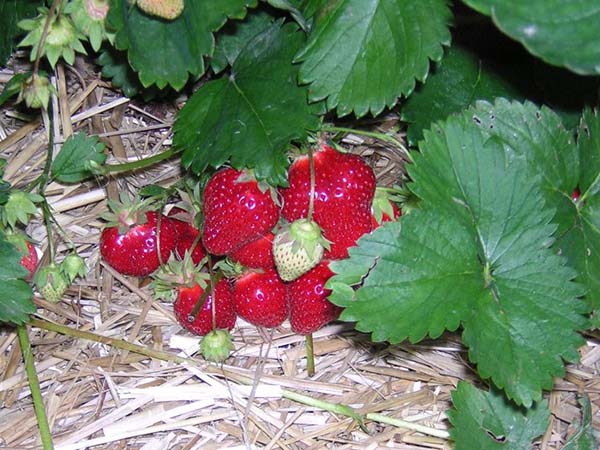
Content
Why mulch strawberries
If you want to grow a rich harvest of strawberries (garden strawberries), and not constantly water, weed from weeds, treat diseases and fight pests, then strawberry beds should be mulched.
The main advantages of mulching garden strawberries:
- Mulch protects the soil under the strawberries from drying out and losing moisture, therefore, it needs less watering.
- The soil remains loose and does not crust (no need to loosen).
- The mulch layer is a kind of "pillow", thanks to which the ground around the strawberry bushes does not heat up.
- It is an excellent protection against weeds and pests (slugs and snails).
But, in fairness, it's worth saying that sometimes mulch, on the contrary, attracts slugs and snails ...
- The berries always stay clean. For example, after rain, if you do not have a mulch layer, then the berries will always be dirty.
- Because thanks to the mulch, the berries do not come into contact with the soil, strawberries are less affected gray mold.
- Mulching improves the structure of the soil, the soil becomes looser and more fertile.
When to mulch: timing
You can and should mulch strawberries 2 times a year: in spring and autumn.
- In the spring, mulch is laid in strawberry beds around May, when the first berry ovaries appear, so that the flower stalks do not come into contact with the soil, in other words, they do not contact the ground. And when the crop is fully harvested, you can remove the mulch, but not for long.
- In autumn, around October, strawberry beds are mulched again, but this time with the aim of sheltering them for the winter. And the next spring (in March-April), the mulch is removed again before the first ovaries appear.
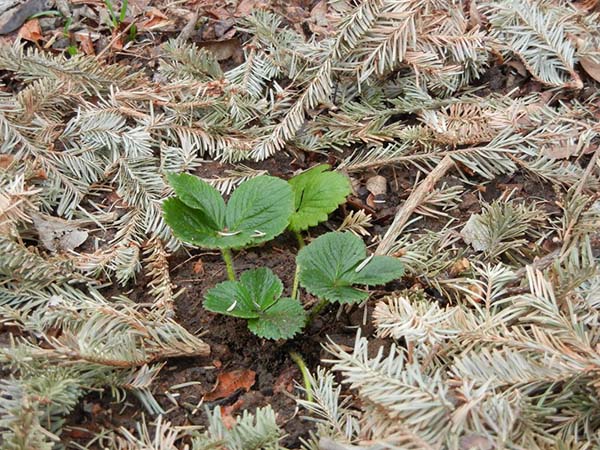
By the way! In the fall, coniferous twigs are suitable as a mulching (covering) material.
Methods and materials for mulching strawberries
Various materials can be used as mulch material for strawberries.
Organic:
- straw, hay;
- cut grass;
- needles (coniferous litter) and pine cones;
- sawdust;
- humus and compost.
Inorganic:
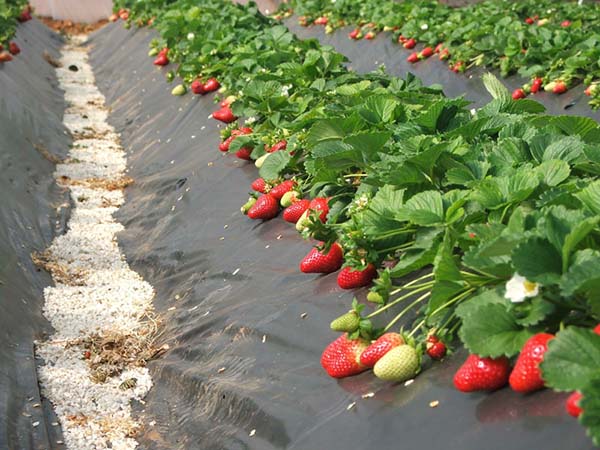
- black film;
- agrofiber (spunbond);
- cardboard.
Next, we will talk in more detail about each of the materials and, accordingly, the method of mulching garden strawberries: what are their advantages and disadvantages, when they should be used (in spring and / or autumn), can they be combined.
Organic Strawberry Mulching Materials
The main advantage of organic mulch is that it enriches the soil with useful organic matter, increasing its fertility. However, such mulching material must be constantly poured, because over time it erodes and goes into the ground.
Mulching with hay and straw
Straw is the most popular material for mulching strawberries.
By the way! It can be very successfully grown under straw andpotatoes.
It is very important to knock out all the weed seeds from the straw before mulching, which is done by active beating, a kind of "shaking out". Then the hay must be soaked and thoroughly dried in the sun, because you can only mulch totally dry straw.
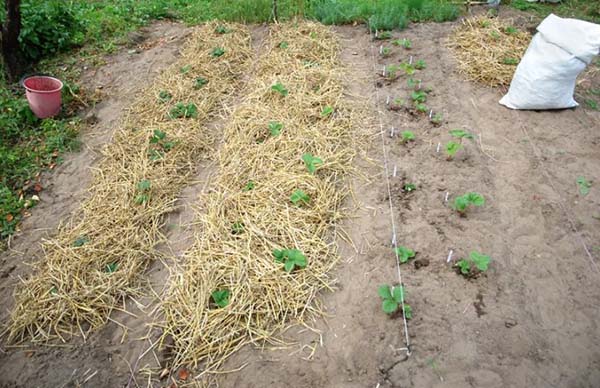
When mulching strawberry beds with straw, remember that the layer of dry hay should be slightly larger than the other mulch. This is due to the fact that such "airy" mulch settles over time, so it is advisable to immediately put 10-15 centimeters. As a result, it will gradually settle, and the layer will become about 5-8 centimeters.
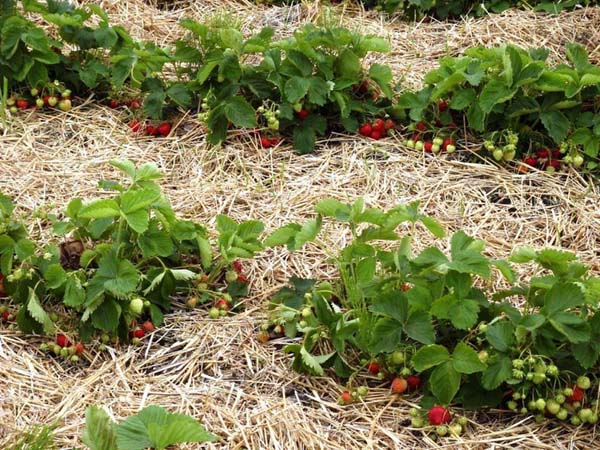
Note! When the straw is rotting in the garden, it becomes a very good organic fertilizer. Moreover, thanks to the decomposition of hay in the soil will start multiply hay stick, and this is a very useful microorganism that perfectly protects against fungal diseases.
Dry straw and hay are suitable for both spring mulching and winter shelter.
Video: mulching strawberries with hay (straw)
Grass mulching
Instead of straw and hay, you can also use ordinary grass (a slightly lying freshly cut lawn), for example, the same torn weeds (but it is imperative that they do not have seeds and, of course, they should not have roots). But, as a rule, mowed lawn grass from under a lawn mower is more often used. Its main advantage is that it is small and fits well.
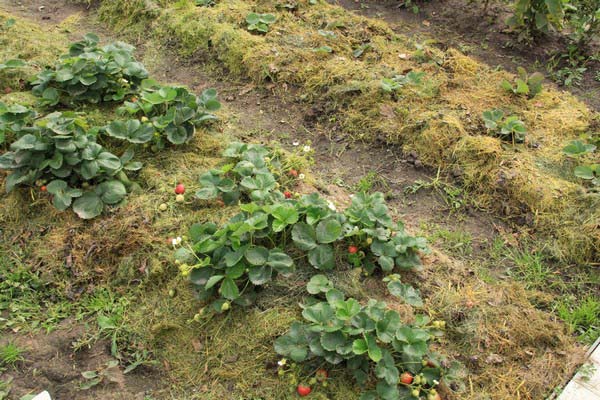
Important! You cannot immediately use freshly cut grass for mulching strawberries, you only need to lay sluggishotherwise it will instantly start to rot and decompose. Therefore, freshly cut grass needs to be held in the sun for a couple of days so that it dries up.
It often happens that the beds with grass mulch are attacked by snails and slugs. If such a phenomenon is not uncommon in your area, then it is advisable to sprinkle the ground with ash and mustard before laying out the mulching layer.
Video: mulching strawberries with grass
Needle and pine cones mulch
Coniferous litter is often used in agriculture as a mulching material; accordingly, it will also be used as mulch for garden strawberries.
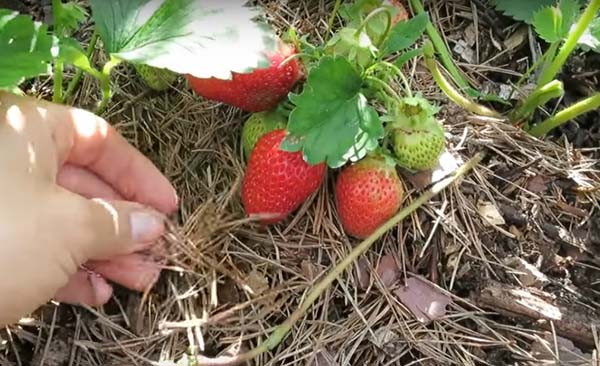
The advantages of such coniferous mulch (from needles and cones) are quite standard: it rots slowly, reflects sunlight, does not allow weeds to break through, retains moisture in the soil, does not really like slugs and snails, and phytoncides in its composition protect plantings from fungal diseases, as well as all kinds of pests.
Not accounted for, but no less important advantage! You can collect coniferous litter in the forest for free.
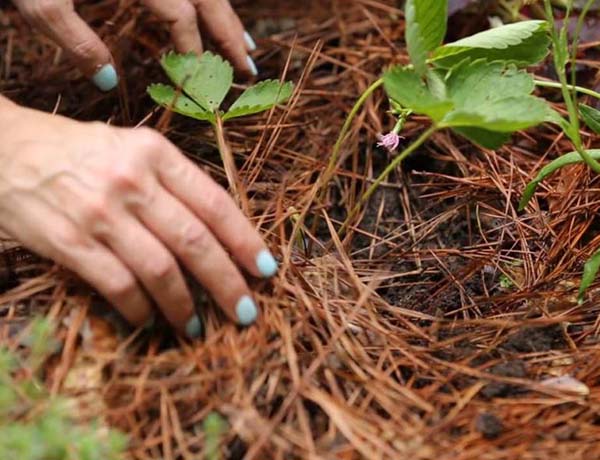
As for the time of use, it is possible to mulch with needles to shelter the beds from frost both in spring and autumn.
Important! It should be understood that the needles and especially the bark of coniferous trees will acidify the soil over time, and this is not very good for strawberries, so you should not overuse its use on already overly acidic soils. But if your soil is not acidic, then there is no need to be afraid... It will take many years (5-10 years) to increase the acidity of neutral soil using such mulching.
Video: mulching strawberries with needles and cones
Sawdust mulching
Mulching material such as sawdust, perfect for keeping weeds free and moisture retaining well in the ground.
Sawdust should be poured in a layer of 5-7 centimeters.
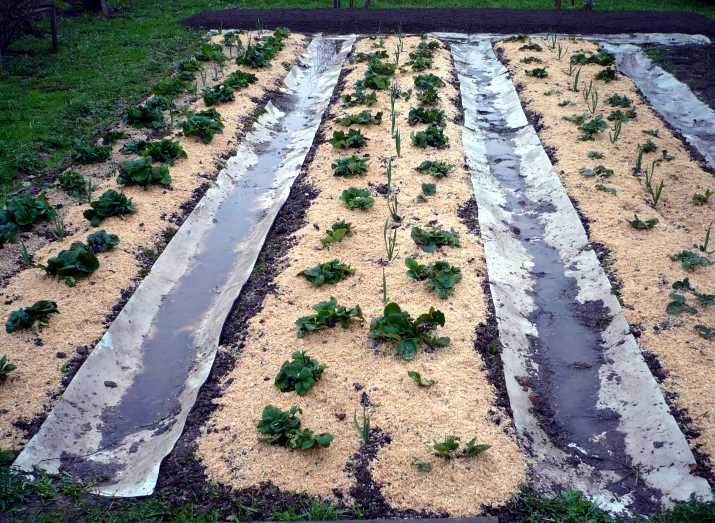
Advice! It is advisable to use rotted sawdust. The fact is that fresh ones extract nitrogen from the soil, so you will have to additionally feed the plantings with nitrogen fertilizers. To make the sawdust faster, you can spill it with urea (carbamide) and ferment it for several weeks (2-3 weeks).
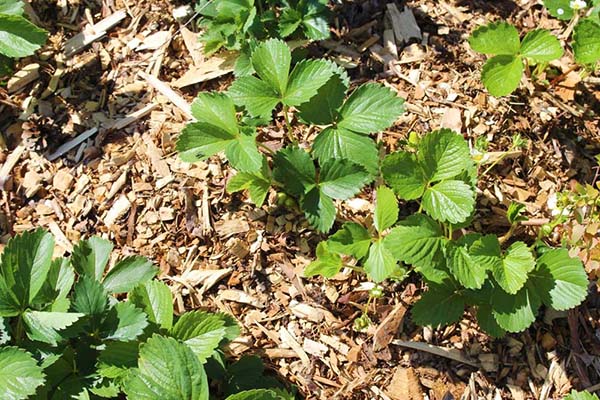
It is better to leave strawberries in the sawdust for the winter. However, many people use them in the spring and summer.
Note! If you use sawdust from coniferous trees, then remember that they acidify the soil, which means that it will not be superfluous to add such deoxidizers to the garden bed as wood ash ordolomite flour.
Video: mulching strawberries with sawdust
Mulching with humus and compost
Humus and compost - not only do they perfectly protect the soil from drying out and weeds, they also nourish and saturate the soil with useful elements best of all.
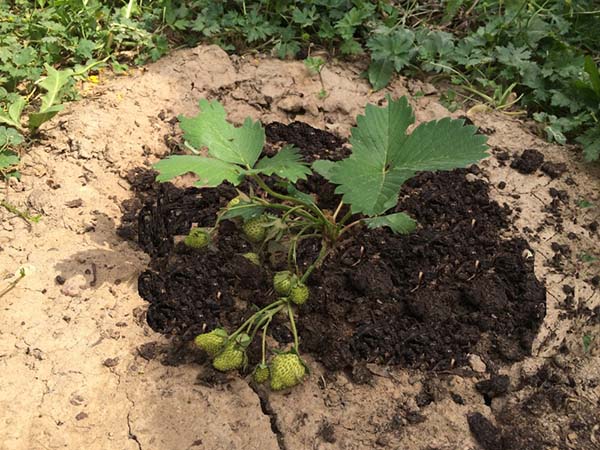
As a rule, this type of mulch is used only in spring and summer.
Important! Humus and compost are quickly absorbed by the soil, so new nutritious mulch should be added during the season.
Inorganic Strawberry Mulching Materials
The main advantage of inorganic mulching materials is their durability. However, they cannot improve the fertility of the soil.
Black film
Note! Both black film and agrofibre are only suitable for mulching in the spring during planting of strawberry seedlings.
Mulching with black film and agrofibre is carried out during the period planting strawberries. Black material is laid out in the garden bed, the edges are laid in the furrow and covered with earth.Then cross-shaped slots or rounded holes are cut through and through them holes are made in the ground and planted there strawberry seedlings.
The main disadvantage of using black polyethylene film is the fact that it does not allow air to pass through and can cause the roots of garden strawberries to wither away, and also during the period of recurrent frosts, condensation can form under it. Again, do not forget that the film does not allow moisture to pass through, which means that you will either have to install internal drip irrigation, or come up with something else.
In the south, it is advisable to use a special film, in which the upper layer is white (gray) and the lower one is black. Such a two-color film significantly reduces the chance of overheating the earth during the scorching summer heat.
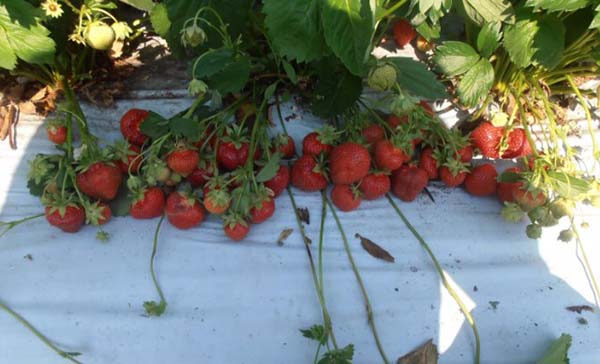
Advice! To prevent the soil under the film from overheating, sprinkle straw, hay or cut grass on top.
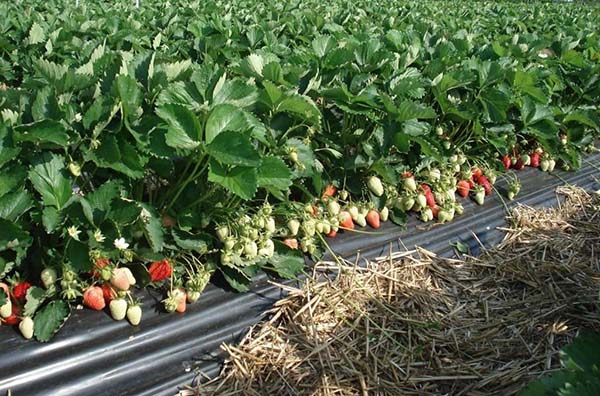
Of course, plastic wrap is more favorable in price, but experienced gardeners, as a rule, still prefer spunbond (agrofibre), which has much more advantages in use. In addition, it is more durable and easier to fix on the garden bed.
Video: mulching strawberries with black film
Agrofibre (spunbond)
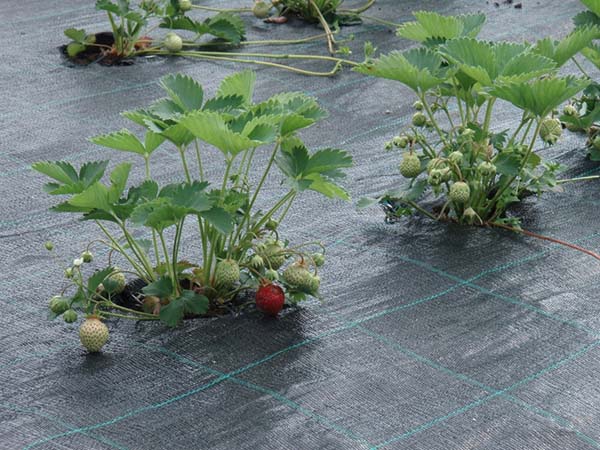
Using agrofibre (spunbond) as mulch for strawberries has the following benefits:
- The berries will always be perfectly clean and ready to eat right away.
- It is very convenient to adjust the mustache.
- Spunbond perfectly permeates and retains moisture.
- Bushes are not washed out during heavy rains and winds, and moisture is not blown out.
- Does not transmit UV rays.
- Naturally, agrofibre inhibits the growth of weeds.
Mulching with cardboard
Cardboard from under old boxes is great for mulching strawberries. Moreover, it is desirable to use the most colorless, because Colored paint often contains lead, which will certainly not be beneficial to plants.
Note! Cardboard is used for mulching strawberries only in spring; this material is not suitable for an autumn shelter for the winter.
When mulching strawberry beds, you need more than cardboard. As a rule, only the first layer is made of it, while mulch is laid in 3 layers:
- 1 layer - sheets of cardboard;
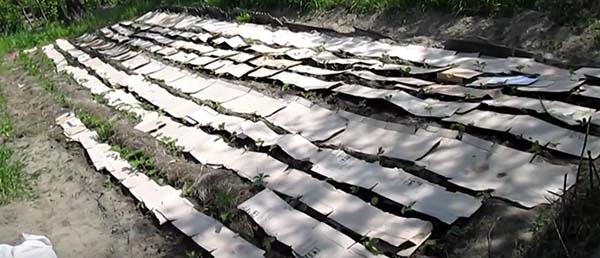
- 2nd layer (for tracks) - synthetic fabric or agrofiber;
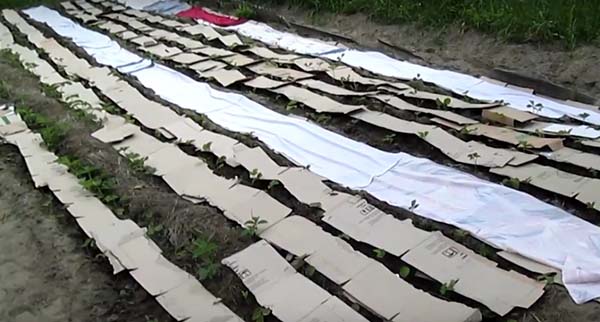
- 3rd layer - grassy, which can be used as straw, hay, freshly cut grass or weeds.
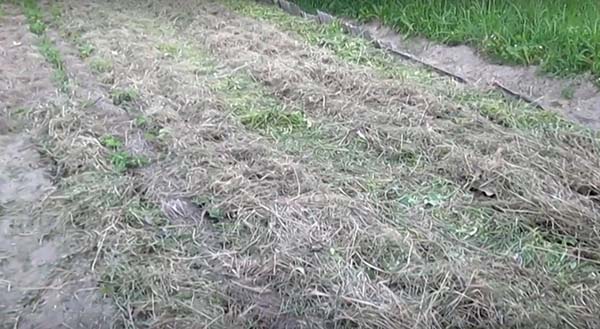
Thus, such mulch will last a full year - from spring to autumn.
Video: mulching garden strawberries with cardboard
If you have already decided to grow an enviable strawberry harvest in the country, it will be useful to use such an agricultural technique as mulching. Everything will turn out quite efficiently if you responsibly and correctly determine the timing, materials and methods of mulching garden strawberries.
Video: 3 ways to plant and mulch strawberries in autumn

